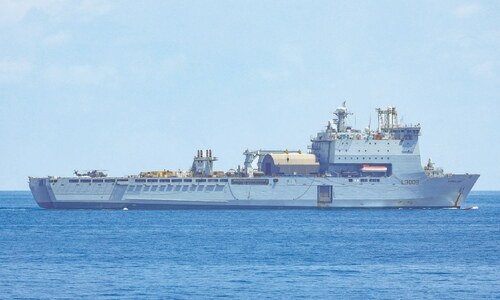JAFFNA: As an army of labourers churns out limestone bricks, archaeologist Prashantha Mandawala reflects on the ambitious task of restoring Sri Lanka’s centuries-old Jaffna fort, destroyed by ethnic war.
The project has so far included the dangerous task of clearing unexploded mines and shells from the seafront site and scouring the northern Jaffna peninsula for scarce limestone bricks to use for the rebuilding.
Sri Lanka’s separatist Tamil rebels laid siege to the European-built fort, branded a symbol of colonial oppression, during the conflict that raged on the island until 2009.
“There was damage due to the war. Artillery fire and things like that,” said Mandawala, who is heading the mammoth restoration of the 17th-century complex.
“There was a lot of damage due to neglect also. Trees had grown inside causing damage to walls,” he said. “Then there was also vandalism. Some people whose houses were damaged during the war had vandalised the fort to remove limestone to rebuild their homes.”
When the Dutch and British ruled Sri Lanka in the 1600 and 1700s, the fortress was a sign of European military might in the Indian Ocean region, a star-shaped structure with moats and draw bridges.
But it was the Portuguese who originally built on the site, 400 kilometres north of Colombo, constructing a small garrison after capturing the region in 1619.
The Dutch ousted the Portuguese in 1658, and set about turning the structure into a massive military post, similar to one in the southern coastal town of Galle.
The British, who expelled the Dutch in the late 18th-century, added a stately residence for its governor who was based in Jaffna, then the gateway to Sri Lanka.
Cleared of mines
Hundreds of years later after Sri Lanka gained independence, the fort came under attack from Tamil rebels, fighting for a separate homeland for the island’s ethnic minority.
Rebels went on the rampage to successfully recapture the fort from Sri Lankan troops who occupied the site after Indian forces exited the conflict in 1990.
The military eventually had to be evacuated by helicopter, and Tigers set about destroying the strategically important site’s features.
“They wanted to prevent the Sri Lankan military getting control of the fort which was a staging post for attacks in the past,” Tamil legislator from Jaffna, Dharmalingam Sithadthan, told AFP.
After the rebels were crushed in 2009, authorities began the painstaking task of restoration, with financial help from the Dutch government.
The moat was cleared of mines, artillery shells and other unexploded ammunition, allowing ramparts and bastions to be rebuilt, and several hundred tourists a month to take a tour.
About 150 labourers are now holed up inside, making artificial limestone bricks by mixing cement, crushed limestone and sand. They churn out 300 bricks a day, although thousands are needed to finish the job.
“The biggest challenge we face in carrying out the restoration is finding coral stone,” Mandawala told AFP. “Environmental laws prevent us from quarrying limestone so we have to improvise.”
Supervisor Kabilan Balasubramaniam said the artificial bricks are the nearest they can get to the real thing, although some stones, salvaged from war-damaged homes, are also being used.
“While dredging the moats, we found a lot of munitions as well as coral stones. We are using those stones in our work,” Balasubramaniam said.
Mandawala, archaeology professor at the University of Sri Jayewadenepura, said progress is slow, with care taken to preserve what is left of the original structures.
The next stage is to restore the bombed Dutch church and the governor’s residence, with the entire project set to be completed by 2018.
The Sri Lankan government has earmarked $212,000 annually for the next three years, but experts say that may not be enough given the size of the project.
Since the end of the war, local and foreign tourists have flocked to Jaffna, capital of ethnic Tamil culture, visiting what was, until recently, the scene of bitter battles.
Another fort nearby on a small island, used as a jail until the 1970s, has been transformed into a boutique hotel run by the navy and offering guests a unique “prison experience”.—AFP
Published in Dawn, November 5th, 2015
On a mobile phone? Get the Dawn Mobile App: Apple Store | Google Play

















































Dear visitor, the comments section is undergoing an overhaul and will return soon.